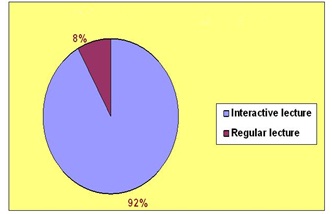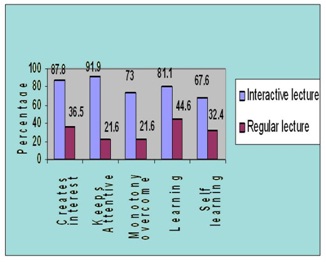Didactic lectures are the common method of teaching for large groups in most professional colleges in India. While traditional lectures are obviously associated with a few advantages, they are not the ideal teaching method for all situations and students [1]. For example, didactic lectures are generally of one hour duration and studies have shown that students attention wanes quickly after twenty minutes of attending lectures [2]. Interactive lectures have been suggested as a means for overcoming the disadvantages associated with regular lectures.
Interactive lecturing means there is some sort of interaction between teachers and students during the lecture. Engagement triggers are incorporated in interactive lectures to break the monotony, thereby maintaining student attention [3]. Interaction can be in any form like questioning the students, using audience responses, playing relevant videotapes, etc. Interactive lecturing should be done for three main reasons: formative, summative and motivational. Formative lecturing aims at guiding student learning, motivational lecturing aims at motivating learning and summative lecturing aims at finding out as to what the students already know [4].
It is well known that the interactive mode of learning is always preferred and that it has been very well analyzed and studied by media, other professional industries, etc. But, interactive teaching is not very common in South Asia. Teachers still follow the ‘teach as I was taught’ approach. Faculties are not trained in facilitation skills and there is no student evaluation of the teacher and the course [6]. Hence, the present study was done to find out the effect of interactive teaching, particularly among undergraduate dental students in South Asia.
Material and Methods
This study was conducted on first year undergraduate dental students (n = 78).
Sample size calculation [
7]
A pilot study on interactive lectures had been done on the previous batch of undergraduate first year dental students by the same authors. It showed that 85% of the students had found interactive lectures to be more useful as compared to regular lectures.
The sample size was calculated using the formula Zà2 PQ / L2 (where Zà is a constant of value 1.96; P (prevalence) = 85%; Q = 100-P=15%; L= allowable error). According to the calculation, 67.76 is the minimum number of samples which is required, i.e. number of students which is required for the study. The present study was done on 78 students, among which 74 students gave their feedbacks.
Methods
The entire batch was exposed to both interactive lectures and regular lectures for the cardiovascular system in physiology. Among the total number of 12 lectures in cardiovascular system, alternate lectures were conducted in interactive style. The number of interactive lectures and regular lectures were six each. Each lecture lasted for one hour.
There were three lectures per week as per the teaching schedule (Mondays: 1-2 pm, Wednesdays: 1-2 pm and Fridays: 8-9 am), with regular lectures and interactive lectures being conducted alternately. The entire cardiovascular system was completed in four weeks. The lectures of the entire cardiovascular block were handled by three faculty members, with each faculty member handling two interactive and two regular lecture classes.
The various techniques that were used for making the lectures interactive were:
A) “Each one - teach one” - at regular intervals during the lecture, the faculty stops for one to two minutes and asks each one of the students to teach their neighbour one important point which was already covered in the lecture.
B) Posing relevant case vignettes at the start of the lecture.
C) Playing appropriate video clippings during the lecture.
D) Questioning by the lecturer (multiple choice questions, filling up the blanks, marking as true or false) at regular intervals during the lecture.
At the end of the 12 lecture series, students’ feedbacks were obtained by using a structured five point Likert scale questionnaire, to elicit whether the specific lectures which were conducted during the series kept them attentive, created interest, overcame monotony, motivated them for self learning and provided well defined learning. The questionnaire was validated and tested for reliability. The Cronbach’s alpha value for the questionnaire was 0.637. The students were also asked to grade their preferences for various techniques used in interactive lectures.
Written informed consents for participation and publications of their feedbacks were obtained from all the participants of the study. The project was approved by the corresponding author’s institutional ethics committee.
Statistical Analysis
All collective data was analysed by using SPSS software, version 15. The frequencies were described in percentages.
Results
Among the total number of 78 students, feedbacks were given by 74 (94.8%) students. The remaining four students did not give any feedback.
Interactive lectures were perceived to be more useful than regular lectures by 92% of the students [Table/Fig-1].
Students’ preference on lecture method

Almost 92% of students agreed or strongly agreed that interactive lectures kept them attentive, whereas only 21.6% of students agreed or strongly agreed that regular lectures kept them attentive. This difference was statistically significant (p < 0.001). Likewise, significantly more number of students agreed or strongly agreed that interactive lectures created interest, overcame monotony, motivated them for self learning and provided well defined learning than regular lectures. A comparison of students’ opinions on interactive lectures and regular lectures has been given in [Table/Fig-2].
Comparison ofstudents’ opinion on interactive and regular lectures

The students supported interactive lectures more than the regular lectures for all the five variables, as has been shown in [Table/Fig-3]. Among the different techniques used to make lectures interactive, the students preferred use of video clippings (58.1%), followed by “each one – teach one” (36.5%) [Table/Fig-4].
Students’ perception of interactive lectures Figures in parenthesis indicate percentage
| Variables | Number of students who Strongly agree | Number of students who Agree | Number of students who are Neutral | Number of students who Disagree | Number of students who Strongly disagree | Mode | Interquartile Range |
|---|
| Keeps Attentive | 41 (55.4) | 27 (36.5) | 6 (8.1) | 0 | 0 | 1 | 1-2 |
| Creates interest | 30 (40.5) | 35 (47.3) | 9 (12.2) | 0 | 0 | 2 | 1-2 |
| Monotony overcome | 13 (17.6) | 41 (55.4) | 18 (24.3) | 2 (2.7) | 0 | 2 | 2-3 |
| Provides well defined learning | 19 (25.7) | 41 (55.4) | 11 (14.9) | 2 (2.7) | 1 (1.4) | 2 | 1-2 |
| Motivates for self learning | 14 (18.9) | 36 (48.6) | 21 (28.4) | 1 (1.4) | 2 (2.7) | 2 | 2-3 |
Techniques liked by the students
| Techniques | Students who like the technique |
|---|
| In Numbers | In percentage |
|---|
| Video clippings | 43 | 58.1% |
| Each one - Teach one | 27 | 36.5% |
| Questioning | 25 | 33.8% |
| Case vignettes | 21 | 28.4% |
Discussion
Lectures are the traditional way of teaching large groups. A didactic lecture is good for presenting information and providing explanations, but because it lacks active participation, it is not a very effective teaching/learning method. Lecture method of teaching has been much criticized, sometimes to the extent of being called as ‘lecturalgia’ [8]. The most important disadvantage associated with didactic lectures is that they are boring and that they cause people to sleep.
Lectures cannot and should not be done away with; instead, they could be made more interesting. AMEE guide for lectures provides a good outline on the art of lecturing [1]. The lecturer is more like a cook, who gathers raw stuff from the book, adds his knowledge, spices it up with various anecdotes, etc. and serves it impressively on a plate (platform). He also has to try different recipes (styles of delivery) at different times, because after some time, familiarity leads to contempt.
Interactive lectures, as the name suggests, are a sort of dialogue in which the teacher requires students to do something beyond passive reception (active learning) [9]. Interaction can address most of the pitfalls associated with regular lectures. It can improve student participation and satisfaction levels of students and faculty [10].
Two points have to be remembered while an interactive lecture is being designed [11]:
The lecture has to be divided into segments.
Activities for student participation should be created.
There are umpteen numbers of activities that can be employed for student participation [11]. We employed a few of these techniques in this study, as has been shown in methodology. The results of the present study showed that the students found interactive lectures to be better than regular lectures in all the five parameters which were tested i.e. usefulness, overcoming monotony, keeping students attentive and interested and providing motivation for self learning. One fact that should not be forgotten however, is that the students were not blinded to the aims of the study and that hence it would have been a bit natural for them to be biased.
Jennifer K Knight and William B Wood, in their study, have shown that interactive teaching resulted in significantly better learning and increased understanding of concepts [12].
Gulpinar and Yegen [13] have shown that interactive lectures increase the problem solving skills of students.
Student–teacher interaction can be monitored using techniques like videotaping and peer review. Prinz JF et al., have demonstrated two methods of monitoring student-teacher interaction, namely, real-time analysis of individual contributions by an observer and automated analysis of audio tapes by an off line computer. These methods can be used as a feedback by the faculty to improve their teaching and interactive skills [14]. Sometimes, conflicts arise during interactions and these should be effectively handled. Demonstrating good interpersonal behaviour and effective communication skills and using techniques which foster collaboration are necessary [15].
When there are so many benefits of interactive lectures, why are they not being routinely advocated? Fear is the most important factor which prevents teachers from advocating interactive lectures. Fear of not being able to cover the portion, fear of non response and ridicule by the students, fear of not knowing the answer to a question posed by a student, may be the reasons [6].
Interactive lectures are a pleasant way of increasing the students’ interest in learning. The benefits of interactive lecturing have to be emphasized in medical education and faculty development programmes. Workshops can be conducted in favour of the same [16]. Programmes like SCALE-UP (Student-Centred Active Learning Environment with Upside-down Pedagogies) can be developed to promote interactive teaching and active learning [17].
Conclusion
Interactive lectures were more accepted and were considered to be more useful than regular lectures by the students. Results of the present study support the use of interactive lectures for ensuring increased interest and attention of students during lectures. Various techniques can be developed by various teachers, which suit the requirements and facilities which are available.
However, further work is needed to confirm that acceptance of this method, in fact, leads to better learning by the students (the next level of Kirkpatrick’s model), which can be done by establishment of a positive correlation between interactive classes and right answers at the end of class student assessments.